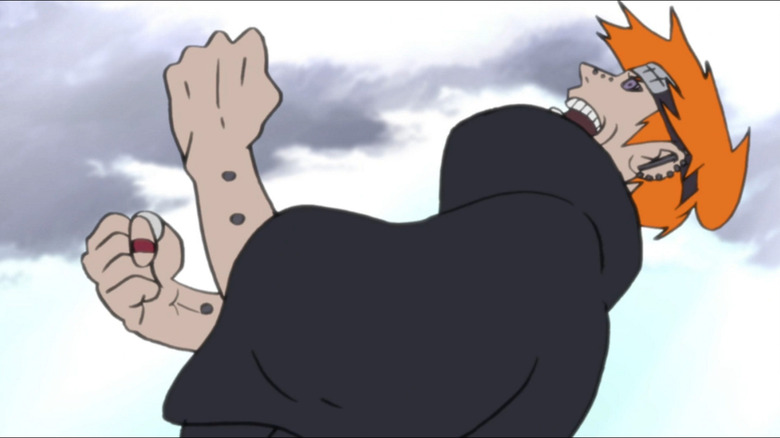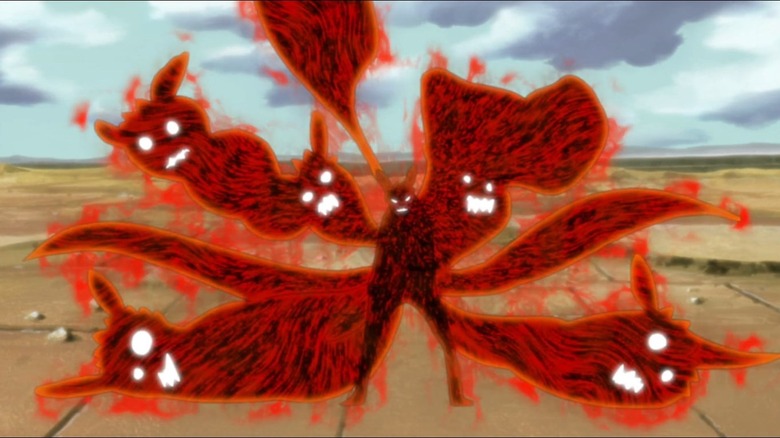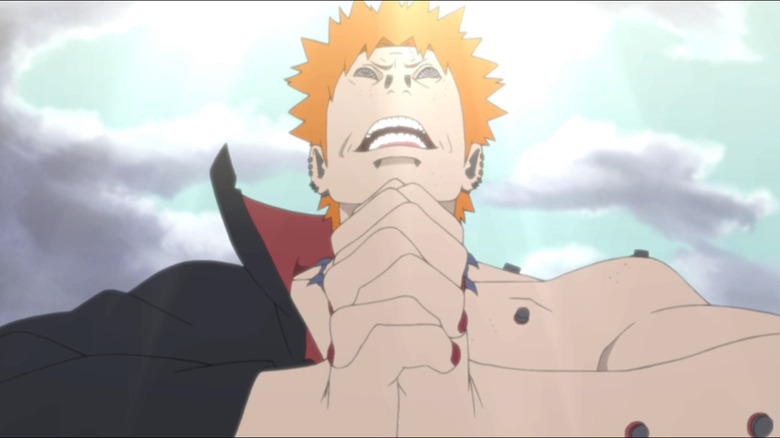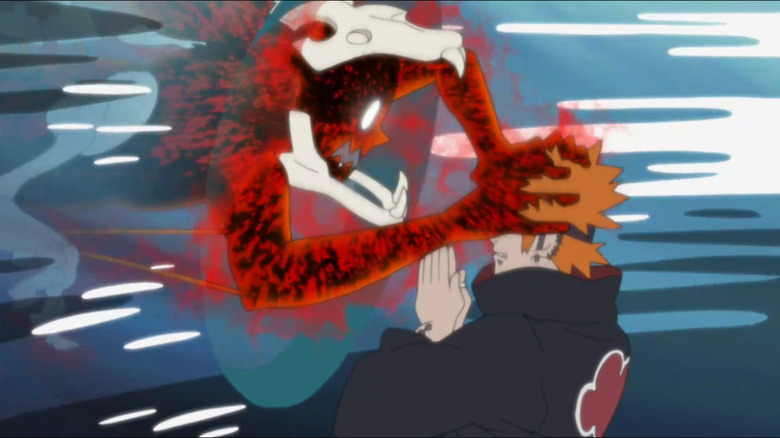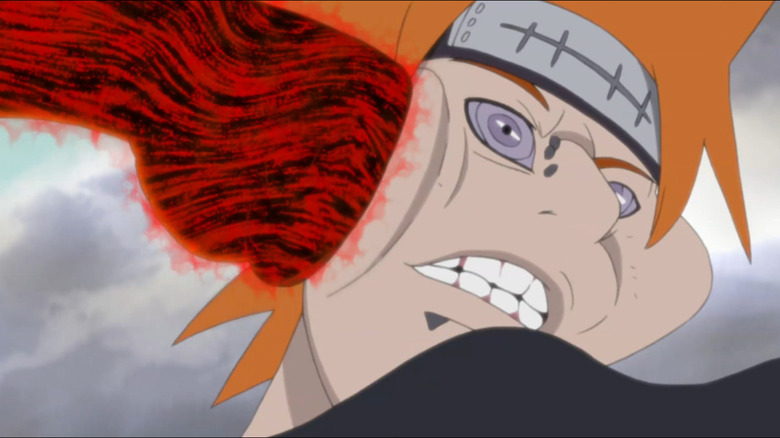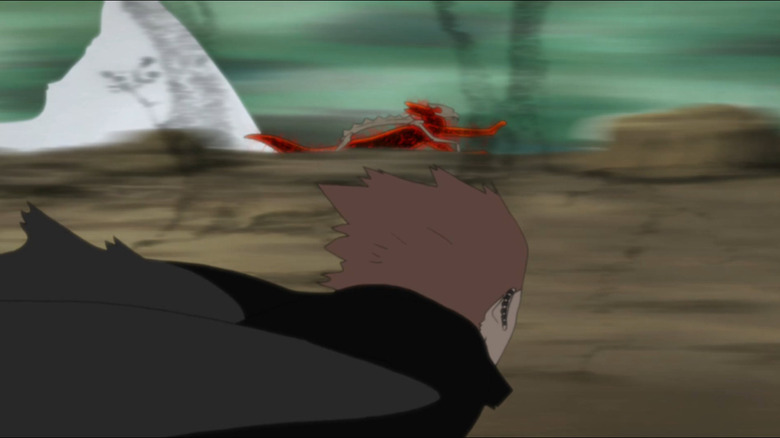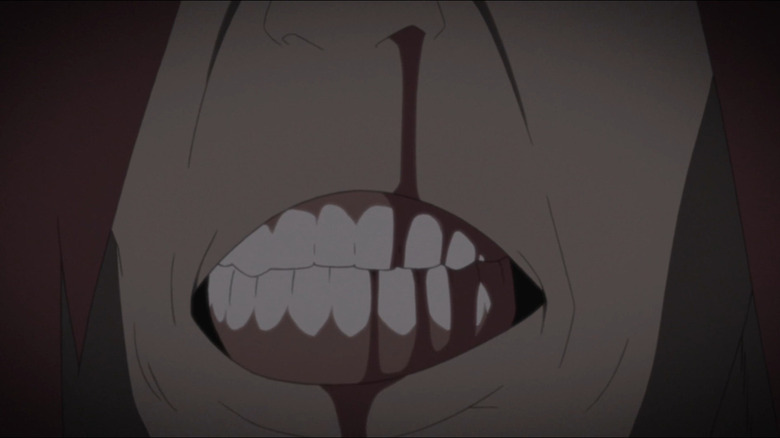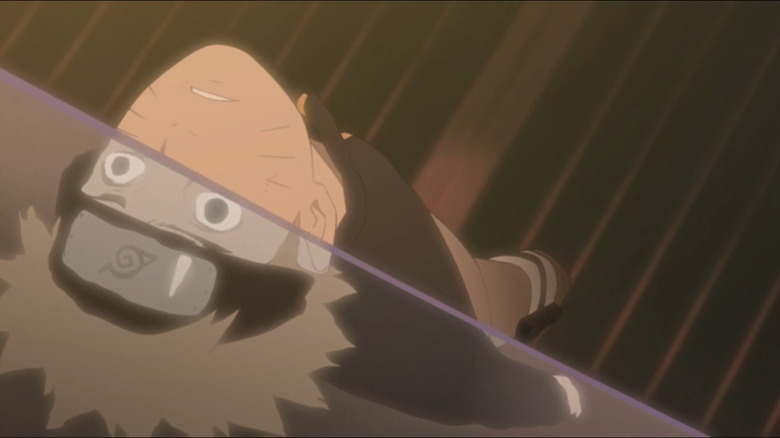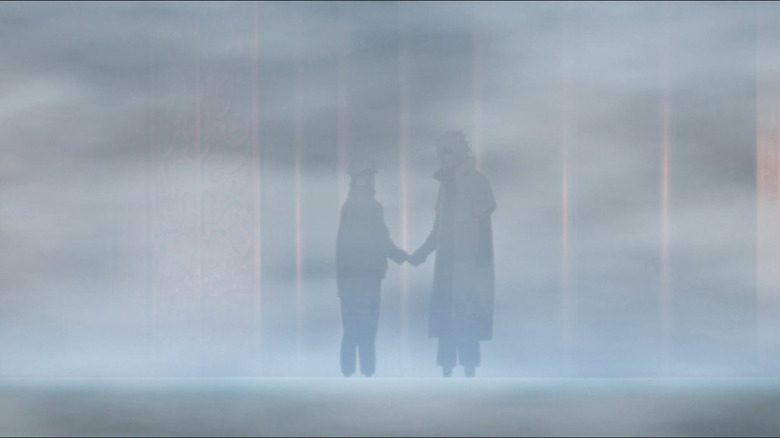The Naruto Fight That Changed Animation History
One of the most memorable sequences in the classic anime "Naruto" is an early fight in episode 30 between Sasuke, Naruto's rival, and the villainous snake-man Orochimaru. Dramatic camera angles heighten the action, but keep the detailed hand-to-hand combat legible. Sasuke's body springs off-model as he throws kunai and breathes fire with his whole strength. Orochimaru runs so quickly that he outpaces his own dust-cloud, stretching serpent-like across three-dimensional space. Yet Sasuke, by using the all-seeing Sharingan eyes passed through his family lineage, is able to trace Orochimaru's movements. It's an incredible scene that could only have been done in animation, and arguably exceeds "Naruto" creator Masashi Kishimoto's original work.
According to Shingo Yamashita, one of the most talented animators and directors today, it was episode 30 of "Naruto" (which aired on April 23, 2003) that set him on the path to becoming an animator. As a young person, he hoped to one day create drawings able to convey the sheer power he saw in the fight between Sasuke and Orochimaru. Little did he know that seven years later, at the age of 22, he would work alongside his professional idols on episode 167 of the sequel series to "Naruto," "Naruto Shippuden."
Some animation fans consider it to be the single most ambitious and outrageous episode in the entire series. Others were left angry and upset. How could an episode drawn in such an unusual style, they thought, represent "Naruto" at its best? A generational shift in the anime industry was underway, and "Naruto Shippuden" was caught right in the middle.
My pain is far greater than yours
Episode 167 of "Naruto Shippuden," which aired on July 1 2010, tackles the climax of the battle between the heroic ninja Naruto Uzumaki and the vengeful demigod Pain. Pain intends to extract the all-powerful Nine-Tailed Fox spirit from Naruto's body to use for his own purposes. Hinata, a young woman who loves Naruto from afar, rushes in to defend him, but is horribly injured by Pain. In his rage, Naruto succumbs to the anger of the Nine-Tailed Fox and becomes a horrible spirit creature. Pain struggles to counter Naruto's monstrous strength, and is forced to resort to a technique called "Planetary Devastation." Pulling from his deepest reserves of power, he traps Naruto in a sphere of earth the size of a small planetoid. Naruto is tempted to give complete control to the Nine-Tailed Fox in his body, but is stopped at the last second by the lingering ghost of his father.
The Pain arc is one of the most beloved storylines in "Naruto Shippuden," a dramatic clash of ideals that is deeper and nastier than is typical for the series. Its villain is not just an enemy to defeat, but an argument that the protagonist needs to refute. Doing the story justice on the screen would take time, money and the best talent available. But "Naruto" is a product as well as art. The logistical challenges of producing hundreds of episodes on time and on budget meant that the team making the series had to pick their battles carefully. Episode 167 of "Shippuden" was chosen to be an exception to the rule, a special effort by the geniuses behind the Sasuke and Orochimaru fight to convey the full shock and awe of Naruto's battle with Pain. No expenses would be spared, no quarter given.
The man who wanted to make history
Just like episode 30 of "Naruto," episode 167 of "Shippuden" was directed and storyboarded by Atsushi Wakabayashi. Wakabayashi made his name on "Yu Yu Hakusho," known to western viewers as a beloved member of Cartoon Network's Toonami airing block. The sequences he supervised, often in collaboration with idiosyncratic director Akiyuki Shinbo, were some of the most stunning and ambitious of the 1990s. After bouncing from project to project, he landed on "Naruto," where he would personally handle three of the best-loved episodes in the series. The first was the aforementioned episode 30. The second was episode 71, which aired on February 18 2004, depicting Orochimaru's fight with the powerful Third Hokage. The third was episode 133, which aired on May 4 2005, capturing Naruto's climactic struggle to prevent his rival and friend Sasuke from joining Orochimaru's side.
These three episodes were true labors of love. In an interview with the magazine Animage, translated by Wave Motion Cannon, Wakabayashi speaks of spending six to seven weeks storyboarding an episode, well over the average. (On the other end of the spectrum, director Masaaki Yuasa would storyboard an episode a week for "Ping Pong," a deathly tight squeeze.) Finished storyboards would be animated over two and a half months, resulting in episodes so expensive and elaborate that the show's producers allowed for just one a year.
Of course, Wakabayashi was paid far less for storyboarding three masterpiece episodes than he would have been for producing many more at a lower standard of quality. "I took the risk of becoming poor working like that," Wakabayashi said. "But I would get an immense satisfaction by doing it ... I wanted to make history."
Norio Matsumoto and the web generation
Just as important to these three episodes as Wakabayashi was the animator Norio Matsumoto. Matsumoto is one of the most influential action animators there is, a master of conveying impactful movement through extreme stretches and smears. In Matsumoto, Wakabayashi had an ally who was talented, fast, and willing to push the boundaries of television action animation as far as they could go. In Wakabayashi, Matsumoto had a collaborator able to play directly to his strengths in storyboards, while giving him the creative freedom he needed to excel. Matsumoto created all the key animation for the first half of episode 30, including the fight between Sasuke and Orochimaru, by himself. It was Norio Matsumoto's animation specifically, in its speed, character and sheer thoroughness, that inspired Shingo Yamashita to become an animator.
Yamashita was not the only young animator to be impressed by Matsumoto. A new generation of artists had come of age on the internet, exchanging their work on websites and forums. Their movement would become known as webgen, the "web generation." Many of them initially lacked the formal training and expertise that defined their predecessors. But sooner or later, ambitious directors began scooping them up, making use of their talents to push the medium forward. Norio Matsumoto himself became a champion for the movement, mentoring many young animators who became future movers and shakers. One of these animators was Shingo Yamashita, who rapidly improved under Matsumoto's guidance.
Planetary Devastation
It was inevitable that, sooner or later, the rough and tumble style practiced by webgen animators would make their way to a blockbuster anime like "Naruto Shippuden." Matsumoto had many young webgen animators among his contacts. His friend Wakabayashi wanted to continue pushing the boundaries of action animation as far as he could. Episode 167 of "Naruto Shippuden," the first episode in the sequel series to be handled by Wakabayashi, presented an opportunity to introduce a wide audience to techniques pioneered in series like "Noein" and "Birdy the Mighty Decode." The episode was handled by just four key animators, including Matsumoto, Wakabayashi, Yamashita and the talented Kenichi Ketsuna. Their back-up included second key animators like Shingo Natsume and Kenichi Fujisawa, who would go on to become big names in their own right.
At the time, ambitious episodes featuring just a few animators were very rare. Today, it is practically unheard of.
Shingo Yamashita animated the first several minutes of episode 167 all by himself. Examined side-by-side with the source material, the differences are clear. Naruto's transformation into the fox spirit in the manga is interpreted by Yamashita as a rapidly mutating orange blob. The level of detail depicted on screen is reduced to bare essentials. In one scene, Pain's face is punched in such a way that his face becomes rubbery. According to a Crunchyroll interview with Yamashita, Pain's expression was modeled on a water balloon thrown to the ground at high speed. In another scene, Pain moves into battle so quickly that his face and eyes stretch like putty. It is in moments like this where you can see Matsumoto's influence. Rather than keep the characters on model, Yamashita prioritizes vertiginous motion and speed. The result looks like no other episode of the "Naruto" franchise before or since.
The power of the nine tails
Of course, that very uniqueness is why the episode is so divisive. Many anime fans see on-model drawings as a requirement for good animation. To them, characters drawn off model herald low budgets and lazy animators. An episode like 167, which breaks the show's style at a climactic moment, is an easy mark for criticism. But episode 167 was also blasted for deviating from the manga's story as well as its art. The episode expands upon the fight depicted in the comic by featuring a sequence in which Pain floods Naruto's village with water from deep under the earth. It's a great opportunity for Yamashita to draw rushing water and steam, heightening the sense of speed. Yet fans fixated upon it as further evidence that the animators tampered with the source material when they didn't need to.
"I think a lot of people assume that I tend to change storyboards, and am basically running wild during production," Shingo Yamashita said in another Crunchyroll interview. Yet this is not the case. "I tend to stick to the storyboards as laid out...I've always been able to deliver what the animation directors are looking for..."
Yamashita did not fly off the handle working on episode 167. Instead, he did exactly what Wakabayashi asked him to do, which was to execute a long and very ambitious action sequence with just a few young animators to provide backup. Perhaps the only reason Yamashita could do something like this at all was via technology pioneered by fellow webgen animators. While fans today look down upon software like Flash, its ease of use allowed animators like Yamashita to check their work far more quickly and efficiently than with traditional cell animation.
A battle of gods
Shingo Yamashita was only 22 years old when he animated his section of episode 167. Fans like PurpleGeth, who has been researching the production of Naruto for years on their Twitter, have said on occasion that Yamashita's lack of experience shows through in the animation. But to them, the raw drawings of Yamashita and company are also what makes the episode so memorable. So much anime is produced today that even the most talented animators rarely have the time or opportunity to show personality in their drawings. Fans themselves insist upon faithfulness even when changes are required in adaptation to ensure the best possible experience in a new medium. Episode 167 presented a rare opportunity for animators like Yamashita and Fujisawa to tackle challenging material in their own respective styles.
It should be said as well that the drama of episode 167, in theory, lends itself to an extreme approach. The story depicts Naruto going berserk against a strong foe, whose only chance of defeating him is to pull out all the stops. This is not an episode about two mortal opponents and their vendetta, but one that is about two godlike entities bending the laws of physics and casualty in their efforts to kill each other. Episode 167 simply makes use of the medium of animation to achieve this effect, rather than simply transferring the literal events of the manga to the screen.
Breaking the seal
Episode 167 of "Naruto Shippuden" brought the artistic ambitions of the staff into conflict with the expectations of the show's audience. Wakabayashi sought to create the grandest spectacle yet seen in the series. Matsumoto, Yamashita and Fujisawa worked hard to realize that vision. The producers paid for all of it, setting aside money and time for an episode built from the ground up to be a special event. This practice had worked for episodes 30, 71 and 133 of the original "Naruto." Some of the effects used in episode 167 of "Shippuden" even appear in these earlier episodes. But despite the best efforts of the staff, the fierce excess of episode 167 was a step too far for some fans.
In the years since episode 167, webgen has evolved from a nascent movement to the status quo of the current anime industry. Successive waves of young animators have followed in the footsteps of artists like Yamashita and Fujisawa, making their names in ever more popular productions. The upcoming anime blockbuster "Chainsaw Man" is led by webgen animators, including director Ryu Nakayama and action director Tatsuya Yoshihara. Meanwhile, the web generation has expanded not just to include Japanese animators, but animators from around the world as well. Finding work in the anime industry as a freelancer abroad has never been easier, if only because the industry is desperate for naive freelancers to exploit and discard in today's era of overproduction.
Fathers and sons
Shingo Yamashita has evolved from a talented young animator to a powerhouse director. His series of shorts for the "Pokemon" franchise, titled "Pokemon: Twilight Wings," flesh out the world of "Pokemon Sword and Shield" more effectively than the games themselves ever did. His opening credits sequences for "Jujutsu Kaisen," requested personally by manga artist Gege Akutami, sold audiences on the show's mix of fashionable urban life and grotesque ghostbusting even more effectively than the series proper. That said, my favorite of his works is his ending credits sequence for the dystopian science fiction series "Shinsekai Yori." An impressionistic dream of fire and water, longing and fear, I've carried it in my heart ever since seeing it for the first time in 2012.
"Naruto" is an underdog story; the tale of a young ninja who overcomes the circumstances of his birth to become the leader of his clan. Real life is not so kind. While many of those who worked on episode 167 of "Naruto Shippuden" either became successful or remain so, the circumstances that birthed episode 167 can never be repeated. Most anime produced today are artistically conservative out of necessity. Those who challenge the heavens with ambitious, unconventional work must either compromise or break themselves on the rock. Yet there are still underdogs out there. Just last year, a group of young animators produced a fan-made "Naruto" animated sequence under the name Studio Tonton. These new artists persevered despite their lack of experience to pay tribute to the story they loved. So long as these young artists continue to love and draw fearlessly, the spirit of "Naruto" will never die.
